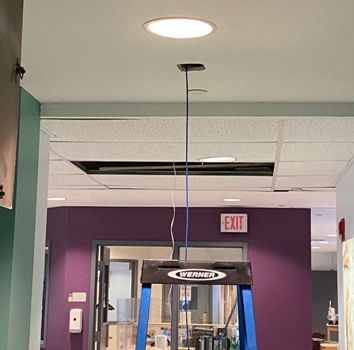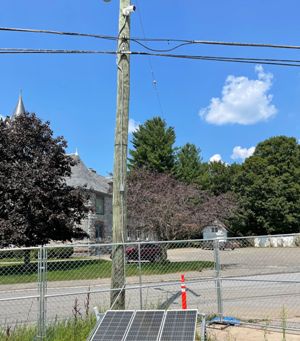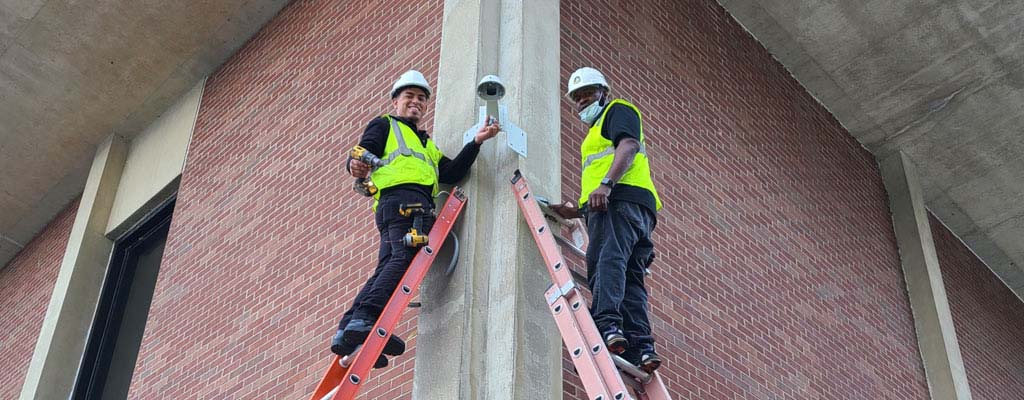Video MGMT System
 Access Control
Access Control
Voice & Data Wiring
 Burglar Alarm
Burglar Alarm
 Fire Alarm
Fire Alarm
Video MGMT System
Voice & Data Wiring
An essential feature in every modern office and commercial building is low-voltage wiring. It's the foundation of safe and reliable access to high-speed telecommunications, digital technologies, and data networks. Low-voltage wiring is necessary for Ethernet cables, fiber optic wiring, Wi-Fi devices, HD video and audio systems, alarm systems, and most automated-building devices. In short, a building with low-voltage wiring can boast superior access to telecommunications and data networks.
Because most modern security systems, computer networks, and telecommunications devices operate entirely or most optimally on low-voltage circuits, installing compatible electrical cables is essential to providing office workers and commercial tenants with professional access to technologies and data networks.

In addition to powering high-speed networks and telecommunications systems, low-voltage wiring supports advanced security tools like intercom systems, smart doorbells, motion sensors, and many automated-building devices.
In the U.S., most of the power outlets and cabling systems in older, unrenovated buildings operate on 120 volts of electricity. Fortunately, an electrical contractor with low-voltage wiring experience and certifications can scale up or newly install low-voltage wiring as part of a previously installed structured-cabling system.
Not only are low-voltage wiring cables less expensive than standard cables in the short term, but they also save even more money in the long run by using a fraction of the voltage required by traditional systems. It's also much easier to add power outlets to a low-voltage wiring system than it is to scale up standard wall outlets.
In addition to saving money and supporting advanced data networks and devices, low-voltage systems are unlikely to cause fires and electric shocks. For this reason, devices that use low-voltage wiring, such as LED lighting bulbs, are suggested for installation in outdoor environments where cables are likely to be exposed to water. Low-voltage lighting systems are also appreciated for their ability to bring out a landscape's natural beauty while being energy efficient.
Voltage refers to how much electricity is pushed through each point of an electric circuit. An electric circuit is an unending loop of energy that is carried around by electrons. The higher the voltage, the more energy each electron carries and the more intensely electricity is pushed through the circuit.
By tapping into a circuit, a device receives its electric charge. If a low-voltage device is tapped into a circuit with high or even mid-range voltage, it could burn out or start a fire.
An appliance labeled 110 VAC (Volts of Alternating Current) is designed to receive 110 volts of electricity in alternating currents every second.
Most electrical wiring, including low-voltage wiring, typically carries AC (alternating current) energy. This means that the circuit loop is constantly moving forward one step and then backward one step--alternating. The circuit is a complete loop, but the electrons don't actually move all the way through the circuit.
As with volts or VAC, hertz is a measurement used to label devices and electrical wiring that uses alternating currents. A hertz denotes the number of times an alternating current switches direction each second. For example, an AC system operating at 60 hertz will alternate its electric current back and forth sixty times in a second.
The power carried in low-voltage wiring must first be carried through high-voltage and then line-voltage wiring. Electric poles and pylons with high-voltage cables connect cities, suburbs, and rural areas to the massive energy produced by generators. Power transmission over these lines typically carries 345,000 volts and can carry up to 500,000 volts.
While high-voltage wiring is a cost-effective method for connecting disparate locations with electricity from a main generator, the voltage must be reduced dramatically before it is brought into individual homes and commercial buildings.
The electric system in the U.S. relies on a step-down transformer to lower the voltage carried by high-voltage wiring to 120 volts before arriving at a building's electric meter and main electric panel.
From there, the electricity travels through cables with line-voltage wiring, which is wiring designed to carry 120 volts of alternating current energy. Line-voltage wiring is the first layer of a structured-cabling system, which is an organized and standardized method for connecting telecommunications devices with external service providers.
Line-voltage wiring also provides energy to light switches, dimmers, ceiling fans, and most standard wall outlets and appliances, such as dishwashers.
During the first stage of a structured-cabling installation , all of a building's electrical wiring and outlets are designed for the 120-volt U.S. standard. However, in order for the full array of modern security system technologies and telecommunications devices to function properly, a low-voltage electrical network foundation must be layered onto a structured-cabling system.

As with the transformer used to reduce high-voltages to line-voltages before they enter buildings, a second step-down transformer is necessary to receive 120-volt inputs from the line-voltage wires and output fifty or fewer volts to be carried by low-voltage wires. Most low-voltage devices operate on 12 volts, 24 volts, or 48 volts of electricity.
In addition to supporting network data systems, telecommunications, and security devices, low-voltage wiring is used to power many automated-building tools, including heating and cooling thermostats and garage door opener controls. While conventional lights are typically compatible with 120-volt power sources, low-voltage lighting systems, including LED lights, require low-voltage wiring.
A low-voltage wiring system involves thin, small-gauge wires made of copper, which happens to be an excellent conductor of energy. These thin copper wires control power transmission to devices by connecting with low-voltage switches and relay systems.
Common types of cable used in low-voltage wiring systems include Cat5 and Cat6 cable for high-speed Ethernet connections, RG-6 (coaxial cable) for cable television, and fiber-optic cable to transmit large amounts of data at high speeds.
Low-voltage wiring requires different installation know-how and operates under different regulating bodies than traditional electrical wiring systems.
Despite the strict regulations and new specialized educational requirements that stop other electrical contractors in their tracks, our installation team at Mammoth Security has the skill, education, and licensing necessary to meet the low-voltage electrical wiring needs of professional offices and commercial buildings.
While most standard wall outlets and older buildings in the U.S. operate on 120 volts of electricity, low-voltage cabling is essential for high-speed and reliable access to data networks and telecommunications technologies, as well as many modern security, lighting, and building automation systems.
At Mammoth Security, our team of experienced technicians has the knowledge and skill to seamlessly upgrade or upscale your property's structured-cabling system with low-voltage wiring that meets the highest standards of a professional commercial installation in the twenty-first century.

You can trust our team at Mammoth Security to develop and install the right security solutions to protect your commercial property. From alarms and access control to cameras and cabling, we take pride in what we do, and we’d love to share our expertise and workmanship with you.
If you're ready to take the next step toward securing your property, just fill out the simple form below to set up a free, zero-obligation site consultation. You’ll meet a friendly member of our team as we survey your property, discuss your security concerns, spot points where your security can be improved, and begin to develop a security system that’s expertly tailored to your site’s unique layout and security needs.

Wireless
IP Cameras
Wireless cameras are not reliable enough for commercial use yet. Instead, we use purpose-built antennae to connect hardwired cameras on light poles and buildings.

Phone App
For Camera Systems
Watch live or previously recorded footage on any mobile device. Save it to your phone and e-mail it just like any other video or image.

Increased Resolution
Of 4096×2160
4k or 8MP cameras represent the best value at the moment. Depending on your situation, a 30+ megapixel camera can be installed allowing you to read a seat number from the opposite end of a football field.

Employ The Same Technology As These Companies:


